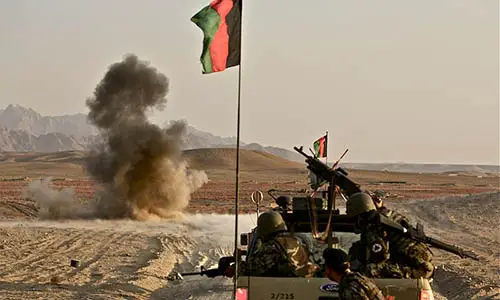Living in the Shadow of Grim Battle, Blood Shed and Fear
On June 30, 2015, a convoy of American soldiers narrowly escaped a fatal suicide bomb attack in Kabul. Adding to their woes, they found themselves at the receiving end of an irate crowd of Afghans, who were trying to help out the civilians injured in the bombing. This report came out in the New York Times.
The suicide attack was carried out by detonating a car bomb on the Airport Road. The blast killed at least one afghan citizen and left 22 wounded. Amidst all the confusion and scuffle, one American soldier got injured, perhaps with a knife. The gathered crowd shouted anti-American slogan and accused the soldiers of firing gunshots on them after the suicide attack.
This incident is an outcome of persistent conflicts that have ravaged the war-torn nation over the past several decades.
Key Facts About Conflicts in Afghanistan:
1. The Soviet Union invaded and took control of Afghanistan in 1979. It was the beginning of communism rule in the nation that lasted for over a decade.
2. In 1980, the Soviet authorities had placed Babrak Karmal as the ruler. However, conflicts intensified as various Mujahideen groups opposed this move and started fighting Soviet troops. There were allegations that countries such as the U.S, China, Iran, Pakistan and Saudi Arabia provided funding and arms to the rebels.
3. In 1985, the Mujahideen groups became stronger as they formed an alliance in Pakistan. Their objective was to strengthen their forces against the Soviets. This resulted in displacement of nearly half of the Afghan population due to erupting war. A large portion of the Afghan population fled to either Iran or Pakistan.
4. The U.S was allegedly supplying Stinger missiles to the rebels so that they could shoot down Soviet helicopters. During that time, Najibullah replaced Babrak Karmal as the ruler.
5. In 1988, Afghanistan, the U.S, Soviet Union and Pakistan signed a peace treaty. Subsequently, Soviet Union started pulling out their forces.
6. In 1992, the Soviet ruling ended in Afghanistan. Subsequently, a series of civil wars triggered in Kabul, and the city was later captured by the Taliban in 1996. The anarchy and civil war continued in the nation.
7. In 1998, the U.S launched missile strikes at bases of militant Osama bin Laden in retaliation for masterminding the bomb attacks at the U.S embassies in Africa.
8. After the terror attacks on September 11, 2001, an allied force comprising American, Allied, and anti-Taliban forces toppled the Taliban.
9. In early 2002, the first contingent of NATO-led International Security Assistance Force (ISAF) was deployed for the purpose of fighting the Taliban and maintaining peace in the nation.
10. In late 2006, NATO took over the responsibility of providing security across Afghanistan by taking command from a US-led coalition force.
11. In 2008, President Karzai announced that Afghanistan may send forces across the border into Pakistan to fight militants if the neighboring nation refused to take action against the rebels.
12. During the same time period, the Taliban resorted to more terror killings as they could not take on the NATO and U.S. forces in direct combat.
13. In September, 2008, U.S President George Bush sent an additional 4,500 troops to Afghanistan as reinforcement to bring down the surging Taliban.
14. In 2009, NATO countries decided to increase military reinforcement after the U.S dispatched 17,000 additional forces. In the same year, the newly-elected President Obama decided to boost the U.S forces in Afghanistan by additional 30,000.
15. In June 2011, the number of U.S forces was withdrawn at a steady pace. In the beginning, 10,000 soldiers came back home by the end of that year. Subsequently, 33,000 more soldiers returned by the summer of 2012.
Due to hostile extremist movements and political/ideological conflicts Afghanistan suffered for decades. The U.S and its allied forces tried to provide protection to Afghans against constantly evolving terror threats. Now, after NATO and the U.S have pulled out majority of their forces, conflicts and anarchy still persist in the nation.










Leave a Reply